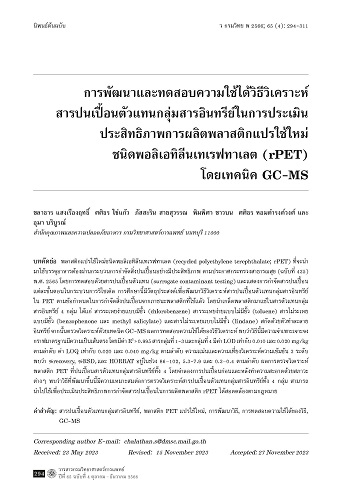การพัฒนาและทดสอบความใช้ได้วิธีวิเคราะห์สารปนเปื้อนตัวแทนกลุ่มสารอินทรีย์ในการประเมินประสิทธิภาพการผลิตพลาสติกแปรใช้ใหม่ชนิดพอลิเอทิลีนเทเรฟทาเลต (rPET) โดยเทคนิค GC-MS
การพัฒนาวิธีวิเคราะห์สารปนเปื้อนตัวแทนในพลาสติกแปรใช้ใหม่
คำสำคัญ:
สารปนเปื้อนตัวแทนกลุ่มสารอินทรีย์, พลาสติก PET แปรใช้ใหม่, การพัฒนาวิธีวิเคราะห์, การทดสอบความใช้ได้ของวิธี, GC-MSบทคัดย่อ
พลาสติกแปรใช้ใหม่ชนิดพอลิเอทิลีนเทเรฟทาเลต (recycled polyethylene terephthalate; rPET) ที่จะนำมาใช้บรรจุอาหารต้องผ่านกระบวนการกำจัดสิ่งปนเปื้อนอย่างมีประสิทธิภาพ ตามประกาศกระทรวงสาธารณสุข (ฉบับที่ 435) พ.ศ. 2565 โดยการทดสอบด้วยสารปนเปื้อนตัวแทน (surrogate contaminant testing) และแสดงการกำจัดสารปนเปื้อนแต่ละขั้นตอนในกระบวนการรีไซเคิล การศึกษานี้มีวัตถุประสงค์เพื่อพัฒนาวิธีวิเคราะห์สารปนเปื้อนตัวแทนกลุ่มสารอินทรีย์ใน PET ตามข้อกำหนดในการกำจัดสิ่งปนเปื้อนจากภาชนะพลาสติกที่ใช้แล้ว โดยนำเกล็ดพลาสติกมาแช่ในสารตัวแทนกลุ่มสารอินทรีย์ 4 กลุ่ม ได้แก่ สารระเหยง่ายแบบมีขั้ว (chlorobenzene) สารระเหยง่ายแบบไม่มีขั้ว (toluene) สารไม่ระเหยแบบมีขั้ว (benzophenone และ methyl salicylate) และสารไม่ระเหยแบบไม่มีขั้ว (lindane) สกัดด้วยตัวทำละลายอินทรีย์ จากนั้นตรวจวิเคราะห์ด้วยเทคนิค GC-MS ผลการทดสอบความใช้ได้ของวิธีวิเคราะห์ พบว่าวิธีนี้มีความจำเพาะเจาะจงกราฟมาตรฐานมีความเป็นเส้นตรง โดยมีค่า R2 > 0.995 สารกลุ่มที่ 1−3 และกลุ่มที่ 4 มีค่า LOD เท่ากับ 0.010 และ 0.020 mg/kg ตามลำดับ ค่า LOQ เท่ากับ 0.020 และ 0.040 mg/kg ตามลำดับ ความแม่นและความเที่ยงวิเคราะห์ความเข้มข้น 3 ระดับ พบว่า %recovery, %RSDr และ HORRAT อยู่ในช่วง 86–102, 5.3−7.9 และ 0.3–0.4 ตามลำดับ ผลการตรวจวิเคราะห์พลาสติก PET ที่ปนเปื้อนสารตัวแทนกลุ่มสารอินทรีย์ทั้ง 4 โดยจำลองการปนเปื้อนก่อนและหลังทำความสะอาดด้วยสภาวะต่างๆ พบว่าวิธีที่พัฒนาขึ้นนี้มีความเหมาะสมต่อการตรวจวิเคราะห์สารปนเปื้อนตัวแทนกลุ่มสารอินทรีย์ทั้ง 4 กลุ่ม สามารถนำไปใช้เพื่อประเมินประสิทธิภาพการกำจัดสารปนเปื้อนในการผลิตพลาสติก rPET ได้สอดคล้องตามกฎหมาย
เอกสารอ้างอิง
Statista. Annual production of plastics worldwide from 1950 to 2021. [online]. 2022; [cited 2023 Apr 3]; [1 screen]. Available from: URL:https://www.statista.com/statistics/282732/global-production-of-plastics-since-1950/.
Nkwachukwu OI, Chima CH, Ikenna AO, Albert L. Focus on potential environmental issues on plastic world towards a sustainable plastic recycling in developing countries. Int J Ind Chem 2013; 4: 34. (13 pages).
Ferdous W, Manalo A, Siddique R, Mendis P, Zhuge Y, Wong HS, et al. Recycling of landfill wastes (tyres, plastics and glass) in construction–a review on global waste generation, performance, application and future opportunities. Resour Conserv Recycl 2021; 173: 105745. (13 pages).
Organization for Economic Co-operation and Development (OECE). Global plastics outlook: policy scenarios to 2060. [online]. 2022; [cited 2023 Mar 31]; [28 screens]. Available from: URL: https://read.oecd-ilibrary.org/view/?ref=1143_1143481-88j1bxuktr&title=GlobalPlastics-Outlook-Policy-Scenariosto-2060-Policy-Highlights.
Mendes AC, Pedersen GA. Perspectives on sustainable food packaging:–is bio-based plastics a solution?. Trends Food Sci Technol 2021; 112: 839-46.
Thiounn T, Smith RC. Advances and approaches for chemical recycling of plastic waste. J Polym Sci 2020; 58(10): 1347-64.
Nisticò R. Polyethylene terephthalate (PET) in the packaging industry. Polym Test 2020; 90: 106707. (18 pages).
Welle F. Twenty years of PET bottle to bottle recycling—An overview. Resour Conserv Recycl 2011; 55(11): 865-75.
Awaja F, Pavel D. Recycling of PET. Eur Polym J 2005; 41(7): 1453-77.
Eriksen MK, Christiansen JD, Daugaard AE,Astrup TF. Closing the loop for PET, PE and PP waste from households: influence of material properties and product design for plastic recycling. Waste Manag 2019; 96: 75-85.
U.S. Department of Health and Human Services. Use of recycled pastics in food packaging (chemistry considerations): guidance for industry. College Park, MD: Food and Drug Administration; 2021.
EFSA Panel on Food Contact Materials, Enzymes, Flavourings and Processing Aids (CEF). Scientific opinion on the criteria to be used for safety evaluation of a mechanical recycling process to produce recycled PET intended to be used for manufacture of materials and articles in contact with food. EFSA J 2011; 9(7): 2184. (25 pages).
ประกาศกระทรวงสาธารณสุข ฉบับที่ 435 (พ.ศ. 2565) ออกตามความในพระราชบัญญัติอาหาร พ.ศ. 2522 เรื่อง กำหนดคุณภาพหรือมาตรฐานของภาชนะบรรจุที่ทำจากพลาสติก. ราชกิจจานุเบกษา เล่ม 139 ตอนพิเศษ 139 ง (วันที่ 17 มิถุนายน 2565) หน้า 11.
สำนักงานคณะกรรมการอาหารและยา. หลักเกณฑ์ เงื่อนไข และแนวทางการประเมินประสิทธิภาพของ กระบวนการผลิตพลาสติกแปรใช้ใหม่และความปลอดภัยของเม็ดพลาสติกแปรใช้ใหม่สำหรับวัสดุสัมผัสอาหาร. [ออนไลน์]. 2565; [สืบค้น 7 ส.ค. 2566]; [18 หน้า]. เข้าถึงได้ที่: URL:https://food.fda.moph.go.th/media.php?id=512022642669264896&name=EvaluationCriteria.pdf.
Welle F. Investigation into cross-contaminationduring cleaning efficiency testing in PETrecycling. Resour Conserv Recycl 2016; 112: 65-72.
Félix JS, Alfaro P, Nerín C. Pros and cons of analytical methods to quantify surrogate contaminants from the challenge test in recycled polyethylene terephthalate. Anal Chim Acta 2011; 687(1): 67-74.
Latimer GW, editor. Official methods of analysisof AOAC International. 21st ed. Rockville, MD:AOAC International; 2019.
Bratinova S, Raff ael B, Simoneau C. Guidelines for performance criteria and validation procedures of analytical methods used in controls of food contact materials. Luxembourg: European Communities; 2009.
Ellison SLR, Williams A, editors. EURACHEM/CITAC guide: quantifying uncertainty in analytical measurement. 3rd ed. United Kingdom: EURACHEM/CITAC; 2012
Komolprasert V, Lawson AR, Begley TH. Migration of residual contaminants from secondary recycled poly (ethylene terephthalate) into food-simulating solvents, aqueous ethanol and heptane. Food Addit Contam 1997; 14(5): 491-8.
Hossain MS, Rahman MA. Post-consumer PETbottle recycling: chemical dose optimization. J Eng Adv 2020; 01(03): 70-5.
ทิพวรรณ นิ่งน้อย. แนวทางปฏิบัติการทดสอบความถูกต้องของวิธีวิเคราะห์ทางเคมีโดยห้องปฏิบัติการเดียว. นนทบุรี: กรมวิทยาศาสตร์การแพทย์ กระทรวงสาธารณสุข; 2549.

ดาวน์โหลด
เผยแพร่แล้ว
รูปแบบการอ้างอิง
ฉบับ
ประเภทบทความ
สัญญาอนุญาต
ลิขสิทธิ์ (c) 2023 วารสารกรมวิทยาศาสตร์การแพทย์

อนุญาตภายใต้เงื่อนไข Creative Commons Attribution-NonCommercial-NoDerivatives 4.0 International License.



